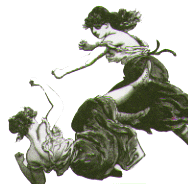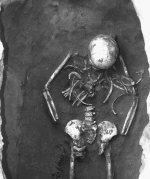
By LAWRENCE OSBORN
ON THE FRIEZES OF THE PARTHENON we see them in their flowing chitons, wielding short swords and javelins like Olympic athletes. Later Hellenistic friezes, like those on the Thessaloniki sarcophagi, depict them in seductive poses, female warriors with the curves of courtesans. According to Herodotus, Greek soldiers fought them--a glamorous and lethal race of one-breasted military dervishes--at the battle of Thermodon, by the Black Sea. The Scythians called them Oiorpata, or "man killers." But when Achilles killed their queen, Penthesilea, at the siege of Troy, he fell in love with her dying face.
The Amazons are among our oldest and most potently ambiguous myths. So persistent is their hold on the Western psyche that when the Spanish navigated a huge river in South America in1542 they sent back reports of Amazon sightings and the river eventually acquired their name. Then, for nearly five hundred years, nada. The Amazons passed quietly into the realm of myth, where they appeared likely to remain.
Or so it seemed, anyway, until archaeologists working on a dig on the Eurasian steppes made an unexpected find. Between 1992 and 1995, a team led by Jeannine Davis-Kimball, director of the Center for the Study of Eurasian Nomads, in Berkeley, California, excavated a site of Neolithic kurgans (burial mounds) near Pokrovka, on the Russia-Kazakhstan border. Last January, Davis-Kimball published an account of the dig in Archaeology magazine: an essay accompanied by maps and photographs describing her evidence that female warriors roamed the steppes approximately twenty-five hundred years ago.
Inside the kurgans, the archaeologists found remains of both sexes, but it was a group of female skeletons that captivated them: women buried with daggers and swords. At an average of five foot six,the women were exceedingly tall for their time. (Modern American women, by contrast, average five foot four.) Arrayed next to one young female was a quiver containing forty bronze-tipped arrows; the skeleton itself had bowed leg bones, possibly, Davis-Kimball speculated, from a lifetime spent in the saddle. Lodged beneath the rib cage of another was a bent arrowhead--testimony, perhaps, to a violent death in battle.
News of the Pokrovka burial site made headlines and set off a flurry of speculation. ancient graves of armed women hint at amazons, proclaimed The New York Times. In fact, Davis-Kimball was careful to tell the Times, these women were probably not the warrior women of ancient legend; after all, they were discovered more than one thousand miles east of where the Greeks allegedly fought the Amazons. Indeed, their significance is likely to be of a more far-reaching sort, revitalizing an old debate about the origins of patriarchy and perhaps renewing a long-discredited quest for a feminist Atlantis, a prehistoric civilization in which women held as much (if not more) power than men.
"These kurgans are not proof of matriarchy by any means," says Davis-Kimball. "But matriarchies might nevertheless have existed." While she underscores that the labels "matriarchy" and "patriarchy" reflect a peculiarly modern conception of power and gender relations, she notes that "there is evidence from iconography in both art and archaeology to suggest that non-patriarchal societies have indeed existed in the past."She adds: "These nomad societies of the steppes certainly seem to show some kind of role sharing between the sexes, even in the supposedly male arena of warfare. Their gender roles, I would say, are more fluid. And, at least now, the question is increasingly wide open."
Russian archaeologists, Davis-Kimball points out, have worked on other kurgan sites in the region since the 1950s, but whenever they came across women buried with swords and daggers they either refrained from interpretive speculation or assumed that the weapons were there for purely ritual purposes. The bowed legs and the spent arrowheads at the Pokrovka site, however, suggest that TV's Xena may, in fact, have somereal-life precursors. Sarah Nelson, an anthropologist at the University of Denver and an expert on East Asian archaeology, puts the case more strongly. "Male archaeologists have been digging up high-caste military burials for years and describing them as male, when in fact they were frequently female," she says. "This might be the significance of the Pokrovka finds: Universal patriarchy, ironically enough, may turn out to be the ultimate male myth!"
By challenging some of our most basic assumptions about the history of gender roles in Western culture, Davis-Kimball's discovery gives new impetus to questions that have long troubled her field. If, as most anthropologists and archaeologists believe, women are subordinate--however subtly--to men in every known society today, how and why did patriarchy arise? Have men always been the more powerful and dominant sex in human societies, or does the historical record suggest otherwise?
IF THESE questions make today's scientists uneasy, it is with good reason. Inferring hard facts about relations between the sexes in ancient societies on the evidence ofskeletal remains and pottery shards is a risky undertaking. Nevertheless, sweeping speculation about the social politics of ancient cultures has a long tradition in archaeology, one whose influence continues to be felt today.
Among the most widely held notions of fin de sièclescholars was a belief in a mother-loving golden age lurking somewhere in Europe's distant past. Both Sir James Frazer in The GoldenBough (1890) and Robert Briffault in The Mothers (1927) hintedat an ancient, female-dominated idyll. The Swiss philologist Johann Jakob Bachofen (1815-1887) in his monumental Mutterrecht undUrreligion, first published in 1926, declared "mother-right" the origin of culture. Bachofen's study of Roman funerary art, undertaken in the 1840s, convinced him that Roman law itself, that bastion of patriarchal thought, contained elements that could only have come from a distant matriarchal past, among them the sacrosanct notion of matrimony still with us today. Bachofen elaborated a romantic vision of pre-patriarchal history, inferred largely from a meticulous study of myth.
During the first half of this century, in an attempt to enhance the discipline's scientific reputation, archaeologists gradually abandoned myth-based speculation for a more sober regime of empirically verifiable observation. Armed with masses of statistics on optimal foraging strategies and population migrations, partisans of the New Archaeology--as the movement came to be called--restricted themselves to cautious assertions about prehistory in the dispassionate, third-person rhetoric ofscience.

There was one archaeologist, however, who found little of value in the rigors of her field, a woman with no patience for the graphs, statistics, and detached tone of the discipline's scholarly journals. In its sweeping scope and grand claims about ancient matriarchy, the work of Lithuanian archaeologist Marija Gimbutas had more in common with Bachofen's freewheeling conjectures than with the dry science of her peers. Gimbutas, who died in 1994, was a professor of archaeology at UCLA and anearly expert on Neolithic cultures of southeastern Europe. During her lifetime, her belief in a lost female Arcadia--supported, she claimed, by thousands of recovered artifacts--gained only a small foothold in academe, primarily among radical feminist scholars like herself. "Of course you can reach some conclusions using statistics," Gimbutas said in 1987, defending her bold approach, "but if you do not have a vision as a person, if you are not a poet, or an artist...you will be just a technician."
In 1974, she published Gods and Goddesses of Old Europe in which she expounded her theory. Ancient Europe, she declared, had been inhabited by a culture that was "matrifocal and probably matrilineal, agricultural and sedentary, egalitarian and peaceful." This edenic society was entirely destroyed by violent Indo-European nomads or Kurgan peoples (named by Gimbutas for their burial mounds--virtually all that remained of them) toward the middle of the fourth millennium b.c. (Ironically, these Kurgans belonged to the same culture as Davis-Kimball's warrior women--though Gimbutas saw them as patriarchal villains.)
Gods and Goddesses of Old Europe features large numbers of photographic plates, which Gimbutas invokes as she takes the reader through a summary tour of some of the thirty thousand artifacts of a long-vanished Neolithic Europe: mysterious stumpy "goddesses" in bird masks or wrapped in snake coils, vases painted with bees, butterflies, and dogs, and delicate freestanding stone mushrooms." These symbols remain the only real access to this invigorating, earth-centered, life-reverencing worldview," she wrote. Taking her cue from Bachofen, she argued that ancient Europe had its own female-inspired iconography and civilization long before any influence from Asia or Egypt.
In The Language of the Goddess: Unearthing the Hidden Symbols of Western Civilization (Harper & Row, 1989),Gimbutas added essays to her color plates. Bearing titles such as "The World View of the Culture of the Goddess," the essays laid out an almost Atlantean view of the Old European order. "Its people did not produce lethal weapons or build forts in inaccessible places," she wrote. Instead, inspired by the gentle influence of the goddess, they lived in "comfortable houses," in an "age free of strife." This glorious age ended suddenly and violently, writes Gimbutas, with the arrival of the Kurgan marauders. In her view, their invasions brought aproto-Indo-European language to Europe, as well as previously unknown scourges, such as warfare, military technology, and--worst of all--patriarchy. Graves insoutheastern Europe, she wrote, reveal evidence of suttee--a term that Gimbutas borrowed from the Hindi practice of immolating widows on their husbands' funeral pyres. The invaders, she believed,engaged in the sacrificial killing of women and children, burying them with a dominant male.
It was all downhill from here. Gimbutas's revisionist history dismisses ancient Greece as a culture of "absurd" images and the High Middle Ages as a grim hell that"can boast of greatest creativity in the discovery of tools and methods of torture." And this last, unfortunate period, she asserted, wasonly "the beginning of the dangerous convulsions of androcratic rule which 460 years later reached the peak in Stalin's East Europe with the torture and murder of fifty million women, children and men." The Stone Age, by contrast, was, in her conceit, an era of irreproachable feminine piety.
GIMBUSTAS'S goddess theory enjoyed greater currency among feminist theorists in the humanities than in her own field. In her influential polemic The Chalice and the Blade (Harper & Row, 1987), for example, cultural historian Riane Eisler posits the existence of an ancient "gylanic" culture, distinguished by the equal rule of men and women. This period, marked by high cultural achievement, was supplanted some five thousand years ago by a baleful "androcratic" regime, an event that, borrowing from Gimbutas, Eisler blames on a violent Kurgan invasion:
At the core of the invaders' system was the placing of higher value on the power that takes, rather than gives, life. This was the power symbolized by the "masculine" Blade, which early Kurgan cave engravings show these Indo-European invaders literally worshiped. For in their dominator society, ruled by gods--and men--of war, this was the supreme power.
Dismissed by Emory University historian Elizabeth Fox-Genovese in The New York Times as little more than "absurdities," this breezily apocalyptic history has nevertheless been swallowed, albeit more soberly, by other feminist scholars. For example, in Paradoxes of Gender (Yale, 1994), Judith Lorber, a sociologist and professor emerita at Brooklyn College, postulates thousands of years of peaceful non-patriarchal horticulture in southeastern Europe followed by a kind of gloomy oppression scenario, with the erstwhile egalitarian populations transformed by warlike men into a vast exploited class of abused "workers, sexual partners, child bearers, and emotional nurturers."
Inspired by Gimbutas, Lorber relies on artifacts, such as theNeolithic goddess sculptures, to justify her claims for an originalnon-patriarchal society. "These goddess idols have a great significance, I think. Womenunquestionably lost their status at some point, a loss that is still withus," she explains. She stresses, however, that women were probably venerated inthese early cultures because of their food-producing and childbearingroles--she endorses the theory that they invented both beer andbread--not because of any monolithic system called matriarchy.

Although many contemporary archaeologists would supportLorber's conclusions about women's social roles in earlycultures, most are wary of endorsing Gimbutas's Kurgan invasions as the cataclysm that destroyed the ancient order. Inher own field, Gimbutas's influence was short-lived, limited to ahandful of scientists and a handful of sites in eastern Europe, includingthe Neolithic city of Çatal Hüyük in Anatolia, Turkey, and the Minoan palace at Knossos. Mostscientists remained deeply skeptical.
"Gimbutas just leaped all over the place, makingall kinds of unsupported assertions," says Brian Fagan, anarchaeologist at UC-Santa Barbara, echoing a frequent criticism of the Lithuanian's work. "When it comes to the social structures of prehistoric cultures, we're dealing with intangibles." Mary Lefkowitz, a professor ofclassics at Wellesley College and an authority on women in ancient Greece,is equally critical. "Patriarchy is not a conspiracy to which you can ascribe dates and generalizations," she says. "Gimbutas's story tome is just that: a story. You cannot say, `Patriarchy brought in the Iron Age and oppression.'"

 To her critics, Gimbutas's interpretation of theevidence she collected--the
thousands of artifacts documented inphotographic plates in her books--is highly
suspect. In The Faces of the Goddess (Oxford, 1997), a painstaking and
exhaustive account of female deities inearly cultures, Lotte Motz, an expert on
Germanic mythology, argues thatimages of men and animals are just as prolific
as goddess imagery in earlyEuropean cultures. "There clearly was no
introduction of warrior gods and warriorvalues," she writes sternly, "no
imposition of apatriarchal system, and no humiliation of the Goddess." Lauren
Talalay at the Kelsey Museum of Archaeology in Ann Arbor, Michigan,claims that
Gimbutas's work was as marred by gender bias as that ofher Russian peers in the
1950s. Many of the "goddess" figures of the Neolithic, Talalay argues, are
either neuter orhermaphroditic--displaying both female breasts and male
genitals.Unfortunately, she says, the definitively female statues are more
elaborately decoratedand, as a result, have been paid disproportionate
attention by scholars."I certainly don't think we can speculate about the
social structures of Neolithic OldEurope on the basis of ambiguous figurines,"
she says. "The conspiracy notion of goddess worship followed by later male
dominanceis glamorous and politically expedient, but the archaeological
recorddoesn't prove it in the least."
To her critics, Gimbutas's interpretation of theevidence she collected--the
thousands of artifacts documented inphotographic plates in her books--is highly
suspect. In The Faces of the Goddess (Oxford, 1997), a painstaking and
exhaustive account of female deities inearly cultures, Lotte Motz, an expert on
Germanic mythology, argues thatimages of men and animals are just as prolific
as goddess imagery in earlyEuropean cultures. "There clearly was no
introduction of warrior gods and warriorvalues," she writes sternly, "no
imposition of apatriarchal system, and no humiliation of the Goddess." Lauren
Talalay at the Kelsey Museum of Archaeology in Ann Arbor, Michigan,claims that
Gimbutas's work was as marred by gender bias as that ofher Russian peers in the
1950s. Many of the "goddess" figures of the Neolithic, Talalay argues, are
either neuter orhermaphroditic--displaying both female breasts and male
genitals.Unfortunately, she says, the definitively female statues are more
elaborately decoratedand, as a result, have been paid disproportionate
attention by scholars."I certainly don't think we can speculate about the
social structures of Neolithic OldEurope on the basis of ambiguous figurines,"
she says. "The conspiracy notion of goddess worship followed by later male
dominanceis glamorous and politically expedient, but the archaeological
recorddoesn't prove it in the least."

For many scholars, the Pokrovka warrior women serve as thefinal nail in Gimbutas's coffin, putting her male-marauder theorypermanently to rest. "We have this macho myth about the so-called Kurgan nomads, that they werehierarchical warmongers and so forth," says Claudia Chang, anarchaeologist at Sweet Briar College, who works on Kurgan graves in centralAsia. "But in fact, as these recent excavations are showing, their kinship systemoften favored women and enabled them to enter themilitary and social elite."
OF COURSE, once the invasion theory is discarded, there remains thequestion of how patriarchy spread. The answer is unlikely to be simple. ThePokrovka burial mounds date from 500 b.c. to 200 a.d., making them roughlycontemporaneous with the glory days of male-dominated imperial Athens. At the time, says Lefkowitz, Athens wasindisputably patriarchal, a culture in which men effectively owned womenand controlled their assets. In this case, she explains, patriarchy wasprobably a result of the Athenians' obsession with racial purity and with keeping the city'swealth in the hands of its own citizens. "It was their pursuit ofpure citizenship," says Lefkowitz, "that made them obsess about the patrilineal bloodline. To control thoselines they had to control women directly. They had to know who the fatherswere."
This is a very different picture of female social roles fromthe one Davis-Kimball has inferred from her Pokrovka kurgans--a society in which women, not just men, apparently held military and socialpower. The simultaneous existence of nomadic warrior women and subjugated Athenian housewives suggests that two thousand years ago,relations between the sexes varied enormously from one population to thenext. So why and when did patriarchy become the universal norm?

Among the most promising alternatives to Gimbutas's apocalyptic scenario is a gradualist model, found in the work of ColumbiaUniversity anthropologist Sherry Ortner and others, which posits a slow andinevitable transition from prehistoric egalitarianism to male-dominated modernity. In 1972, Ortner published an essay in FeministStudies titled "Is Female to Male as Nature Is toCulture?" Strongly influenced by Simone de Beauvoir and often cited as the beginningof feminist anthropology in the United States, Ortner's essaydeclared flatly that "the search for a genuinely egalitarian, let alone matriarchal, culture hasproved fruitless." Nevertheless, Ortner theorized, there must besome explanation for women's subordination to men, a situation sheclaimed was universal regardless of the variable relative power of women.

Although she wished to disregard any explanation smacking ofbiological determinism, Ortner concluded that the ubiquity of male domination had its roots in the factsof sexual reproduction. Women are nearly everywhere associated with naturebecause of their role in procreation. (Women, as de Beauvoir put it, aremore enslaved to the species by biology.) Furthermore, Ortner argued, all societies concoct rituals that aimto manipulate nature in the interest of culture. Notions of purity andpollution, evident in taboos connected with menstruation, create a genderedopposition between nature (dirtywomen) and culture (clean men) attesting to a powerful societal impulse tocontrol nature's threat. Physically unhampered by their role in reproduction and thereforefree from any symbolic association with nature, men are assigned anantagonistic value--namely, that of culture itself, whose duty it is to assert that control. In anessay published in her book, Making Gender (Beacon Press,1996), Ortner elaborates:
Men emerge as "leaders" and as figures ofauthority, vis-à-vis both women and other men, as a function of engaging in a variety of practices, only some of which arepredicated on power, including trade, exchange, kinship networking, ritual participation, dispute resolution, and so forth. That is, male dominance does not in fact seem to arise from some aggressive "will to power," but from the fact that--as Simone de Beauvoir first suggested in 1949--men as itwere lucked out: their domestic responsibilities can be construed as more episodic than women's and they are more free to travel, congregate, hang out, etc., and thus to do the work of "culture."
Ortner's essay described an inexorable progressionfrom biological fact to symbol to the gender stereotypes that enjoy nearlyuniversal currency today. Patriarchy, she says, "arose as an unintended consequence of arrangements which were originallypurely functional and expedient. That we demonize it as part ofcontemporary feminist politics unfortunately only confuses theissue." Many anthropologists--including feminists--were struck by Ortner's thinking; herwork has enjoyed considerable influence in the field. "By andlarge," says Meg Conkey, a Berkeley anthropologist, "we now think of patriarchy as a by-product of technological and socialupheavals."
One scholar who has followed Ortner's lead isElizabeth Barber, a professor of archaeology and linguistics at OccidentalCollege in Los Angeles. Concentrating on a single technology--textileproduction--in ancient cultures, Barber has used a gradualist model to trace theevolution of gender roles in early human societies. In her patient andbeautifully elaborated book Women's Work, the First 20,000Years (Norton, 1994), Barber uses textile remains to re-create the oftenunrecorded lives of women in ancient societies frequently characterized aspatriarchal.

Barber concludes that two fundamental conditions werenecessary for patriarchy to emerge. First, there was long-distance trade inmetalores, an activity that, she claims, could be more easily conducted andmonopolized by men, since women, burdened by infants and small children,couldn't travel long distances. Second, there was a "secondary products revolution" around 4000 b.c., in which domesticated animals that had traditionally been raised for consumption werekept alive and exploited for their secondary products, including milk,wool, and drafting power. As a result, nutrition and clothing improved, andlarge-scale field cultivation became possible. This last development, she explains, was necessarilymen's work as well. Echoing Ortner, Barber views the division oflabor and gender as "an inevitable evil once subsistence farminghad been left behind." She adds: "The communal, non-hierarchical model only worked insmall, relatively poor Stone Age societies. As soon as people want and needcommodities which they can't grow in their back yard, it breaks downirrevocably."

Nicola Di Cosmo, a historian of East Asia at Harvard, thinksBarber is on the mark. "Gender divisions of labor were probablyefficient and so were adopted as a matter of course," she says."Warfare arises from a competition for resources as trading networksexpand--not from some innate male aggression."
ACCORDING to proponents of the gradualist school, patriarchy is less a maleconspiracy to keep women down than a necessary by-product of a society inwhich progress increasingly depends on mobility and brute strength. Teenagegirls and nursing mothers were simply impractical candidates for the heavy lifting required to build aninfrastructure. Despite its sober tenor and considerable political appealto some--neither sex is to blame for men having more powertoday--the gradualist model is still very much a working hypothesis, one thatsounds plausible (certainly more so than Gimbutas) but that the historicalrecord has yet to verify.
In fact, it may be easier to test the gradualist theoryagainst the future than against the past. After all, if revolutions intechnology once made dominance by men--and thus patriarchy--inevitable, it follows that when machines replace bodies altogether, asthey have arguably begun to do today, patriarchy may well disappear.Indeed, this is exactly what Ortner, among others, predicts. "Just as technological evolution created patriarchy," she says, "sotechnology now has the power to cancel it out because it obviates physicalstrength and equalizes the sexes."
While the future is sure to generate enough data for aninformed analysis, the seven thousand years that lie between the emergence of the first Neolithic villages inTurkey and the urban patriarchy of classical Athens remain frustratinglyobscure--a quagmire of informed speculation, contradictory evidence, and wishfulideological thinking. Will Davis-Kimball's Kurgan women illuminatethis murky chapter in human history?
The answer, of course, depends on whom you ask. Barber, forone, says, "The Pokrovka finds are bound to change our picture ofthe sexes in pre-history." Di Cosmo agrees: "The social order in the nomad cultures may have been much more flexible than itbecame with regard to gender roles. Who knows, perhaps the Amazons have abasis in historical fact after all. It's certainly interesting tonote that Herodotus's ethnographic descriptions of this region have now been largely confirmedby archaeology. It's a fascinating question, whether he was rightabout the Amazons as well."
As for Davis-Kimball, she prefers to continue her Gimbutasianquest for full-fledged matriarchies and Amazons rather than embrace the modest new paradigms supported by most of herpeers. Over the summer, she conducted extensive digs in the XinjiangProvince of China. There she found what she is convinced are well-preserved"priestess mummies," part of a group of enigmatic Caucasian burial sites that Chinese archaeologists haveunearthed over the last decade in the Takla Makan Desert, and which shebelieves are the remains of an ancient culture dating to around 2000 b.c.The significance of this Eurasian culture (to which no name has yet been given) is its evidence of the powerful socialpositions occupied by women: It seems women were shamans and priestesses,perhaps even warriors. Some of their implements, such as cultic spoons andmirrors, as well as the spiraltattoos still visible on their mummified faces and hands, are apparentlysimilar to those uncovered in Pokrovka. This older Eurasian culture mayeven have influenced the later nomads with its example of female prestige.
On a long trip afterward through the museums of central Asia,Davis-Kimball says she found evidence of female warriors and priestesses"all over the place." In July and August, however, while digging in Moldova at sitesparticularly beloved by Gimbutas, Davis-Kimball concluded that the evidence for a goddess culture there was weak. The quest for an ancientmatriarchy, she decided, should take a different tack.
"I think Gimbutas may have been wrong about themother goddess per se," says Davis-Kimball. "But shemay have been right about an underlying, unbroken tradition of female cultic power and wisdom, which hasbeen suppressed since the Middle Ages and especially since the IndustrialRevolution. I found evidence for it all over Asia. A friend of mine waseven cured of a backache in Ufa bya female shaman! The question of matriarchy should not be dismissed by anymeans. It should be an open question because archaeology up to now has beenso slanted against investigating women in history. Men, after all, havealways been afraid of women withpower."
Of course, Davis-Kimball may only be giving new life to oldmyths. "I think she is spearheading a campaign for therevitalization of Gimbutas," says Berkeley's Meg Conkey."Unfortunately, it is a reminder that popular culture and mythology are asmuch a springboard for archaeology as the other way around."
Then again, who knows. The tribe of Penthesilea may stillhave a few surprises for us hidden in its quivers.
Lawrence Osborne is the author of Paris Dreambookand The Poisoned Embrace, both published by Vintage. His article, "Does Man Eat Man? Inside the Great Cannibalism Debate," appeared in the April/May 1997 issue of LF.